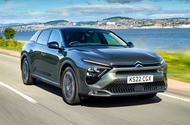C5 X won’t be replaced because its segment is deemed ‘non-existent’
French firm will ditch C5 X to focus on mid-size; Ami quadricycle wins reprieve
Citroën has ruled out smaller and larger models in its future line-up and will instead focus on cars in Europe’s largest mainstream segments.
Speaking to Autocar, CEO Thierry Koskas said the brand “needs to be in the main segments, not niche segments”. This in effect confirms that in future the range would start with the B-segment C3, with the Ami below it, and end with the C-segment C5 Aircross.
Koskas said Citroën has no plans for a replacement for the C1 due to an inability to make it profitable, and he essentially ruled out a replacement for the D-segment C5 X that is “not performing badly but is in a segment that’s non-existent”. He added: “Citroën needs to be in the B- and C-segments as this is the heart of the brand.”
Referencing smaller models, Koskas said there was a “big gap for electric objects” priced between €10,000 and €20,000 between the Ami and the new ë-C3, but the question of filling it is “not easy” to answer. “We have no plans at the moment, but it’s a question of how you fill it,” he said.
“If you go into the A-segment [with a C1 replacement] you would expect to pay less than the B-segment, but the production costs for us are the same.” Citroën will look to use its new value-focused ‘Smart Car’ platform for future models in those core segments to keep costs down.
This architecture, which has been introduced on the new C3, is made using fewer parts so it is cheaper and easier to produce.
Koskas said future Citroëns will not be conventional hatchbacks or SUVs because “it is in the DNA of Citroën to suggest new things”. Instead, the brand will introduce “new shapes that do not exist” on future models. “We will take risks, we need to shake the market and Citroën can do that,” added Koskas. “We will do it in the B- and C-segments, which is the vast majority of the European market. That’s where we need to be.”
Koskas said Citroën’s future line-up will have “not so many” cars, adding: “There’s no magic number, but five or six models well positioned, really appealing to customers… I’d be happy with that.”
Koskas expects most of Citroën’s sales to be electric by 2030, but the brand plans to keep making internal combustion engine models and hybrids because “as a popular brand, we need to offer affordable mobility to all”.
The Smart Car platform is engineered to accommodate pure-combustion, hybrid and pure-electric powertrains, as it does in the C3.
More generally, Citroën will look to keep pushing its message of simplicity and ensuring its models remain affordable and are not loaded with unnecessary equipment. “We’re clear with what we are,” said Koskas. “Affordable cars, simple cars, comfortable cars. We’re not technology Christmas trees.”







